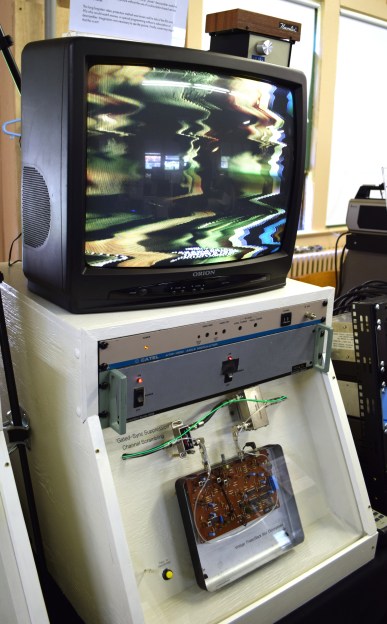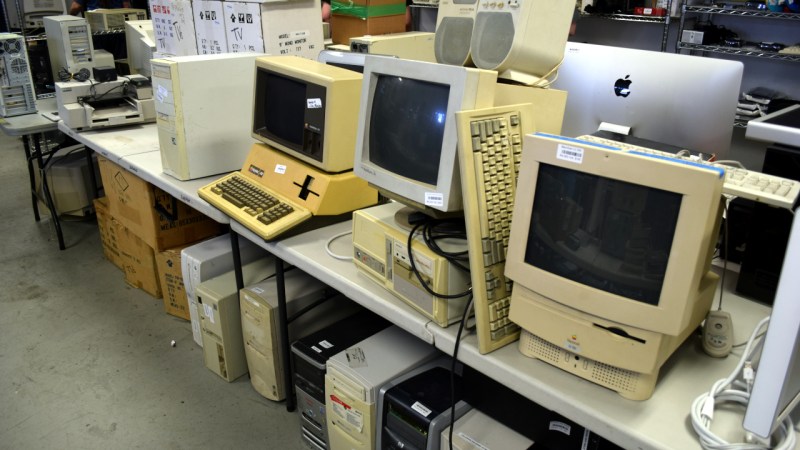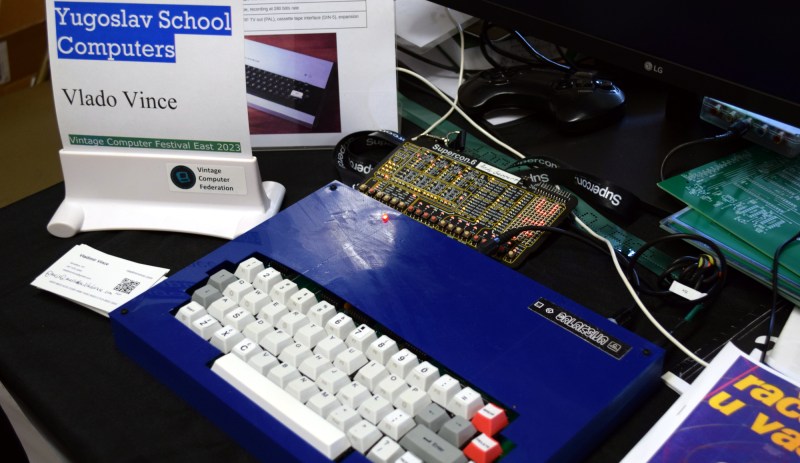The Vintage Computer Festival East took place last weekend at the InfoAge Science and History Museum in New Jersey, and by any metric you care to use, it was a phenomenal success. Everyone you spoke with, from the the exhibitors and attendees, to the veteran volunteers who put this incredible show together, all said the same thing: they’d never seen a turnout like this before.
Of course, such success is not without cost. The exhibit rooms were so packed that moving through them was a challenge, the line to get food or browse the consignment area occasionally stretched outside the building, and at one point the event’s electronic payment system buckled under the pressure.

Yet even the folks who waited the better part of an hour to rummage through boxes of dusty treasures, only to find themselves left standing with armfuls of heavy gear they couldn’t pay for until the technical issues were resolved couldn’t really complain. I should know, I was one of them. It would be like going to a concert and getting upset that the music was too loud — the event was advertised as a festival, and that’s exactly what it was.
No matter where you went, you’d find throngs of excited people who were eager to chat about the golden age of computing. So even if you were stuck in a long line, or had to step outside of the exhibit area to get some fresh air, you were always in excellent company. Seeing such a large and diverse number of people come out for what’s ultimately a niche event was exceptionally gratifying. At the end of the day, if the price we have to pay for this kind of community response is a few long lines and tight squeezes, it’s well worth it.
Each time I cover an event like this for Hackaday, I do so with the caveat that there’s really no substitute for being there in person. No matter how many articles you read and YouTube recaps you watch, you’ll never be able to see all the things you would have had you been able to walk the show floor yourself. It’s a bit like exploring the Moon or Mars: remotely controlled robots are capable of capturing terabytes of data and beaming it back to Earth, but even still, there’s the potential to learn so much more by putting boots on the ground.
The same is true of VCF East 2023 — what I bring you here is just the tip of the iceberg in terms of what was on display at this year’s event. On the other hand, you have the advantage of being able to peruse these images without having to stand in line. Is it worth the trade? Only you can be the judge of that. But for my money, I’ll gladly get back in line when VCF East 2024 rolls around.
Forgotten Cable TV Tech
For many, especially of the younger generations, the term “television” means something very different than it did a few decades ago. Even if they’re watching a show on an actual TV rather than their phone or computer, the content itself is almost certainly being delivered on-demand over the Internet through one of the major streaming services. For them, the technology that allowed cable providers to “scramble” unpaid premium channels in the 1980s and 90s is as arcane as the first transatlantic telegraph cable.
 But those of us who’ve gone around the sun a few more times may remember late nights trying to watch something you weren’t supposed to through frantic technicolor waves of distortion. Sometimes the image would appear perfectly clear for a second or two, only to immediately return to a fever dream of colors and shapes. Yet despite its maddening randomness, the cable company could restore the channel to crystal clarity…for a price.
But those of us who’ve gone around the sun a few more times may remember late nights trying to watch something you weren’t supposed to through frantic technicolor waves of distortion. Sometimes the image would appear perfectly clear for a second or two, only to immediately return to a fever dream of colors and shapes. Yet despite its maddening randomness, the cable company could restore the channel to crystal clarity…for a price.
In their exhibit Behind the Screens, the team behind the impressive WeatherStar hacking we’ve covered previously turn their attention to the nuts and bolts of the cable TV system, including the scramblers that kept untold late-night programs hidden from prying young eyes.
The interactive display demonstrated two forms of scrambling: one which injected additional noise into the signal and could be defeated with a simple passive filter on the customer’s incoming cable line, and a more sophisticated method which reduced the amplitude of the horizontal sync pulses so that a TV couldn’t turn the signal into an intelligible image. The latter could be overcome with a set-top converter, which at first could only be obtained through the cable TV provider, but which was inevitably cloned by pirates.
At the press of a button built into the display the scrambler’s appropriate countermeasure could be activated, instantly clearing the image. Oh what I would have given for a such a button 30 years ago…
Colossal Cave Returns
Under normal circumstances, seeing various old computers running some permutation of Colossal Cave Adventure at VCF wouldn’t be out of the ordinary. In fact, it’s almost exactly the sort of thing you expect to see. But even so, the fact that they were all lined up on one table seemed a bit suspicious. Things become a bit more clear when you notice the nearby table of branded swag, and realize this collection of machines was gathered to commemorate the recent release of a modernized version of the game.
Helmed by Roberta Williams, co-founder of Sierra Entertainment and the creator of the King’s Quest series, this latest take on the classic leaves the text prompt behind for 3D visuals and is available on both computer and game consoles. There’s even a VR version available, if you’ve got the appropriate hardware. There was actually a VR setup there for attendees to play the new Colossal Cave, but in true VCF style, there were far more people waiting to take their turn tapping commands into the original game than seemed interested in exploring the titular cave with modern tech.
Keeping Voja’s Dream Alive
While there’s already plenty of overlap between the Hackaday and retrocomputer communities, there was one particular machine tucked away in the corner of the VCF exhibit hall that falls in the exact center of that particular venn diagram: a modern recreation of Voja Antonić’s Galaksija.
Built by Vlado Vince and part of his Yugoslav School Computers exhibit, this version of the DIY Z80 computer features some niceties such as a 3D printed case and an updated two-layer PCB released by Voja in 2020. Eventually, Vlado says he’d also like to develop a WiFi-to-serial adapter for the computer, as he’s done for the Yugoslavian Orao.
Seeing a Galaksija would be interesting enough, but that’s not where this story ends. When Vlado set up his table at VCF, he ended up sitting right next to Andy Geppert, who brought his Supercon 2022 badge along with him. This chance encounter meant that two computers designed by Voja Antonić, separated by 40 years, ended up within a few feet of each other — providing for a very unique photo opportunity and a great story to entertain attendees with.
Random Access Memories
As I said in the intro, there’s simply no way to describe all the exhibits I saw during VCF East 2023. Even this gallery of photographs represents just a fraction of what was on display, but will hopefully give you an idea of how much classic computing technology was crammed into one building.
If these pictures don’t make you excited to see what’s in store for VCF East 2024, nothing will.
More to Come
Vintage Computer Festival East 2023 was simply too large of an event to cover in just one post. Stay tuned for more coverage from this incredible event, including video interviews with some of the exhibitors and speakers that provide a unique glimpse into their individual passions for retro tech.












































I like the representation of an earlier VCF t-shirt design being displayed on the TRS-80 4P. Very clever!
How far back does one have to go to be considered “vintage”?
When you see stuff you grew up with in museums, you’re vintage.
B^)
How ’bout randomly hearing a radio ad for a *musical* (like, people singing and dancing on stage — I assume) hagiography of a performer who was pretty young when you were in school?
…just happened…
When you start sentences with “when I was your age”
When you fill out an online form and to get to year of birth you spin it like a slot machine.
When you say things like” in my day we computed with 4 bit processors”
When you say “in my day we sent data at 110 baud… uphill and in the snow”
When you watch an an old TV Show/Movie and all you notice is the tech “…look dear…in the back in the corner of that police station that looks like a PC/AT connected to an IBM Dot Matrix printer and maybe a USR modem.. you see it don’t you ? ”
When you have finally used up your last Free AOL online hours CD… 😂😂😂
The VCF museum generally cuts off at around 1995, however the age of the subjects of specific exhibits may vary due to relevance to that years themes or to the vintage computing community.
I can remember pretty much all the computers pictured being the exciting latest and greatest, and I fear that makes me vintage too. But at least I *can* still remember.
Beautiful machines and lots of pleasant memories. Wish I could’ve been there! … About that Model 4P: Is that an optional or early/late keyboard? Mine had four arrow keys in a separate keypad. I remember having to alter MEX so it would recognize them. (I ran Montezuma Micro CP/M 2.2.)
Where do I get that Enterprise graphic?
Wish I knew, it was in the consignment area so nobody to ask. If we’re lucky, perhaps the new/old owner will see this post and can provide some details.
It actually ran through a slideshow of various ship diagrams like this, as well as “fact sheets” for the tricorder and phaser. Conceptually it was very similar to Star Trek: The Screen Saver, but the images were far higher quality.
I look forward to your follow-up article.
It looks lifted from the ‘Star Fleet Technical Manual’, but is clearly not the Enterprise from the less bad ST.
I only had the original, having outgrown Drek by the time the next gen/Q/court drama was produced. Perhaps someone here has that version.
Am I misremembering? IIRC they did print a new SF tech manual while running the franchise into the ground.
I prefer SciFi!
Here you go!
https://archive.org/details/FULLTREK/StarTrek%20DOS/TREK/02.GIF
This is the closest I could find.https://www.cygnus-x1.net/links/lcars/blueprints/entapv.jpg
Looks like a yellow plastic festival!
Some of that equipment is the same color as butter.
Our purpose is to pass the butter.
I’m sure someone was selling a cleaner toget that authentic old computer look.
CATV scrambling:
[Someone I know very well] managed to decode the data stream on a Jerrold 450 CATV system enough to figure out which box addresses on the system had all the channels enabled. They then managed to find the box address byte locations in the PROM that was behind the hatch in every box. They constructed a PROM emulator that replaced the box address locations with the value set by a few thumbwheel switches, allowing the box using the emulator to have any address on the system. It worked.
Those were the days, when a hacked cable box would work for years untouched.
Back then you could make a decoder out of a cable splitter and a short length of coax. You tuned the coax length so the reflection of the inverted horizontal synch step was at the right place on the next scanline.
Wasn’t great, but we were teens. PPV porn was fapable with ghosting. Ref comic: ‘can you look more blocky’.
The data channel was right in the middle of the FM band at around 100MHz. Every time you tuned the box through that frequency, you heard a loud buzzsaw. It was only a matter of time before an FM radio got hooked up to the cable, an oscilloscope was applied to the detector output and the binary (FSK) data appeared. A level shifter, a UART and a micro delivered the raw input data bytes to the hacking process.
There’s another way. The sync pulses are suppressed, but the color burst is not. A TV has to phase lock onto the 3.579545 Mhz color burst to demodulate the color signal. This is an exact multiple of the horizontal and vertical frequencies, so the color subcarrier falls between harmonics of the B/W signal. By digitally dividing this oscillator, it’s possible to generate substitute horizontal and vertical sync pulses of the right frequencies, and use these to replace the suppressed sync pulses.
-> Voja’s linked article
Am happy that the Williams’ are still active in the computer game community. The modernizing of CCA looks good and I wish them luck with it. I really like the old text version though (and, yes, thanks, I know I can download it nearly everywhere) . ;)
And I was there someplace. I saw that trainer. It did not follow me home because of those loose keys. Tom we need to synch our transponders so we both know when we’ll be at the show next year. And that theme will be a gas…..
So many vintage computers (yay!), but also so many people (yipe). It’s a conundrum.
Looking through these images, I finally understand how my father must feel at a vintage car show. He can call off make, model and year for cars from the 1930s through the 1960s. For me, it’s home computers from the 1970s. If I’D been running this image collection, though, there would’ve been at least one each TRS-80 Model I and original PET.
I WAS happy to see the KSR-33 and the ADM-3A+ — or is that a 5? We had 3As and ASR-33s in our high school “computer lab”, talking to a PDP-11 downtown over 300 and 110-baud connections respectively. Those were the bad old days…
I was there as well – great show and congrats to the VCF team for pulling it off! I’ve been to a bunch, and this one was the biggest by far. I got a great demonstration of someone’s Model 15 teletype (which is a mind-boggling mechanism), and I scored an SGI Indy with it’s original keyboard, mouse and IndyCam!
Based on the crowd, it appears that the organizers seriously underestimated the public interest in the event. I hope they can plan a larger venue for the next event.
On another note, who knew that off white and beige were such popular colors for so many vintage machines?
*hand raised*
I was so glad when the beige case era ended.
Well, some of them USED to be whiter, and TURNED more beige with age…
The top cover was off the Altair 8800 when I was there on Saturday. It’s not an original computer – there was a miniITX PC in it running an emulator
We had a couple of IMSAs being worked on over in the makerspace. One needed a ‘new’ memory board (6116s from the early 80’s) to diagnose the other boards. :-)
Hmmmm, I wonder if I have a few 6116 chips in a tube.
Oh, is HM6116 the same thing?
Would you be interested in them? I was saving them for the Zombie Apocalypse.
Those PC speakers on the first picture, so 90s, I had the same on my first PC in 1995.
Thanks to everyone who went and enjoyed all that old stuff. Some of us fought nearly continuously with that old equipment. I, for example, was the go-to guy for adjusting ASR-33 H-plates. Pretty soon I learned how to claim ignorance of them so I could get my coding done.
Sad to see that no-one mentioned the IBM PC 110 in the middle of the pics there, maybe because it’s hard to judge the scale just from that photo. It was a fully Windows-capable PC developed by IBM and Ricoh and released in 1995, weighing only 630g including battery and small enough to fit on the palm of a (large-ish) hand. I still have at least one sitting around here somewhere – managed to get Linux on it, and with Ethernet and Wifi PCMCIA cards and the built-in modem, it was actually useful for a few years as a carriable PC.